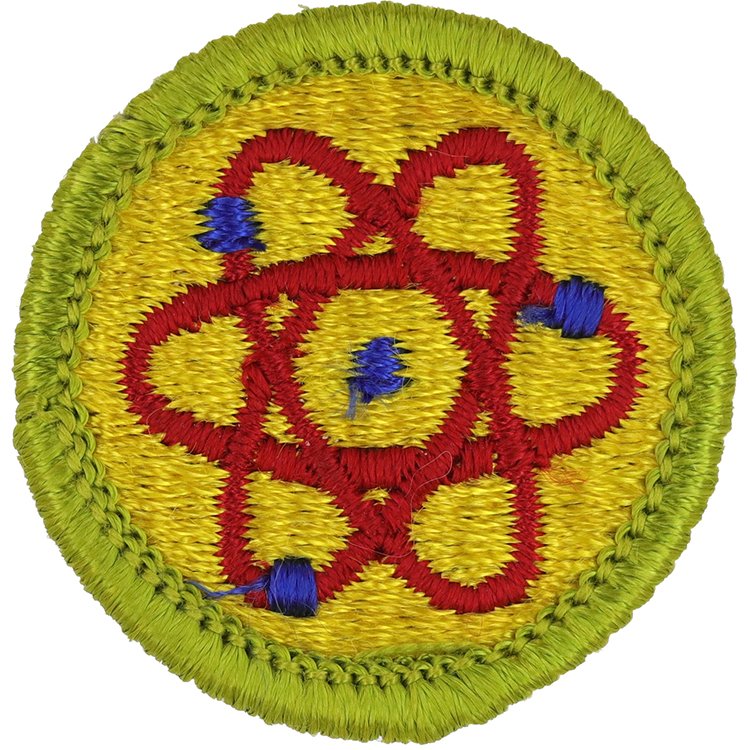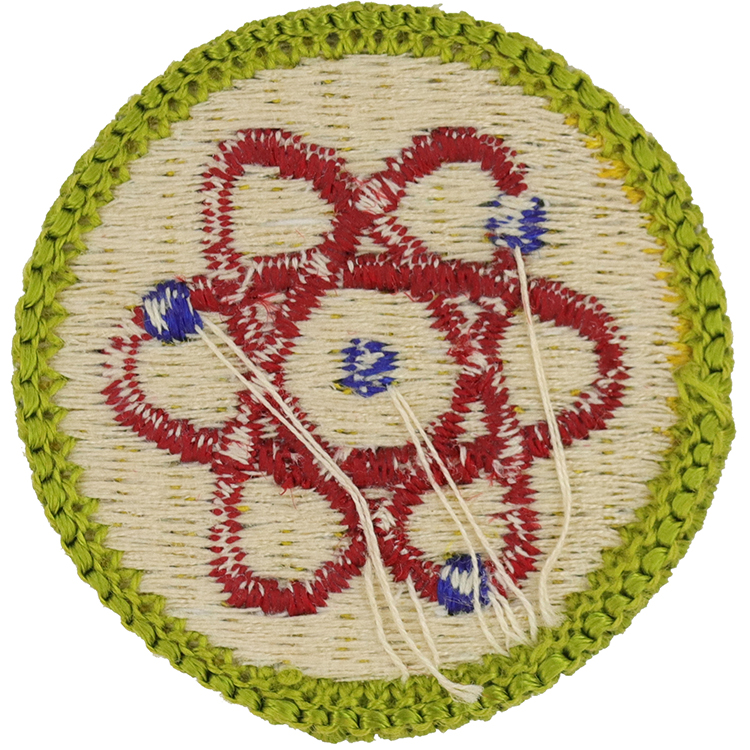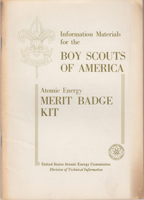
Fig. 1: AtoEne-G2-Front
- Embroidery: Cotton thread
- Design: WITH nucleus
- Border: Merrowed

Fig. 2: AtoEne-G2-Reverse
- Back: Starched cloth
Item Name: Atomic Energy 1964 - 1972
Item ID: AtoEne-G2
Collector Rating: 1
Requirements September 1963 until June 1972
1. Be able to tell your merit badge counselor in your own words the meaning of the following words or terms: alpha particle, atom, background radiation, beta particle, curie, fallout, fission. fusion, gamma ray, dosimeter, half-life, ionization, isotope, neutron activation, nuclear reactor, particle accelerator, radiation, radioactivity, roentgen, and X ray.
2. Construct three-dimensional models of the atoms of the three isotopes of hydrogen, showing neutrons, protons, and electrons. Use these models to explain to your merit badge counselor the difference between atomic weight and atomic number.
3. Draw a diagram showing how nuclear fission happens and label the fissionable material, all neutrons, and the fission products. Draw a second picture showing how a chain reaction could be started and how it could be stopped. Show the drawings to your merit badge counselor and be prepared to demonstrate, using simple material, what is meant by a “critical mass” of fissionable material.
4. Be able to tell your merit badge counselor who five of the following people were and explain what each of the five discovered about atomic energy, nuclear reactions, or radiation: Henri Becquerel, Niels Bohr, Marie Curie, Albert Einstein, Enrico Fermi, Otto Hahn, Ernest Orlando Lawrence, Lise Meitner, William Conrad Rontgen, and Sir Ernest Rutherford. Explain to the satisfaction of your merit badge counselor, how any one person’s discovery was related to one other person’s work.
5. Draw the standard radiation hazard symbol in the proper colors and explain in your own words, to the satisfaction of your merit badge counselor, where the symbol should be used and when it should not be used. Be able to tell your counselor why and how people must use radiation or radioactive materials carefully.
6. Do any THREE of the following ten projects:
(a) Build an electroscope using simple material. Show your merit badge counselor how it works. Put a radiation source inside the electroscope and explain to our counselor any difference observed.
(b) Make a simple Geiger counter and tell your merit badge counselor which parts are the detector, the amplifier, and the indicator. Tell your counselor which types of radiation the counter can detect and how many counts per minute of what radiation you have detected in your home with the Geiger counter.
(c) Build a model of a nuclear reactor, showing the nuclear fuel, the control rods, the radiation shielding, the moderator, and any cooling material. Explain to the satisfaction of your merit badge counselor, how a nuclear reactor could be used to transform nuclear energy into electrical energy or to make things radioactive.
(d) Using a Geiger counter (that you have built or borrowed and a radiation source, show your merit badge counselor how the counts per minute change as the radiation source gets closer to the detector. Place at least three different kinds of material between the source and the detector and explain to your counselor any differences in the counts per minute, Tell your counselor which material you would recommend to shield people from radiation and why.
(e) Using fast-speed film and a radiation source, conduct an experiment illustrating the principles of autoradiography and radiography and show the results to your counselor. Explain in your own words, to the satisfaction of your counselor, what happened to the films and how someone could use this technique in medicine, research, or industry.
(f) Using a Geiger counter (that you have built or borrowed), find a radiation source that your merit badge counselor has hidden under a covering. Repeat the experiment with your counselor for at least three other locations under the cover and draw on a map (representing the cover) the movement and locations of the source. Explain in your own words, to the satisfaction of your counselor, how someone could use this technique in medicine, research, agriculture, or industry.
(g) Arrange, with the assistance of your merit badge counselor, to visit a dentist, physician, veterinarian, or hospital where X-ray equipment is used. Draw a floor plan of the room in which the X-ray equipment is used, showing where the unit, the operator of the unit, and the patient would be when it is used. Show your floor plan to your counselor and be prepared to discuss with him the radiation hazards from the X-ray equipment.
(h) Make a cloud chamber, using simple material. Show your merit badge counselor how the chamber can be used to see the tracks caused by radiation and explain in your own words, to his satisfaction, what is happening.
(I) Arrange, with the assistance of your merit badge counselor, to visit an industrial plant or research laboratory where radioisotopes are being used. Explain, by drawing a simple diagram, how and why the radioisotope is used.
(j) Obtain samples of irradiated seeds and plant them, with a control group of nonirradiated seeds of the same type, and grow both to maturity under the same conditions. Observe and catalog any differences and be prepared to discuss the effects of irradiation of seeds with your counselor.


